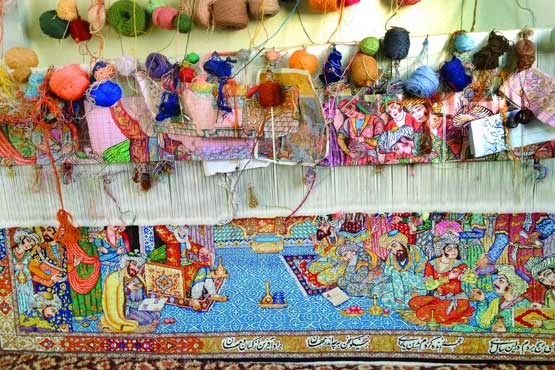Persian village rugs stand as enduring testaments to the rich weaving traditions woven into the fabric of Iran’s cultural heritage. Scattered across the picturesque landscapes of the country, hundreds of villages have nurtured generations of skilled artisans who, with deft hands and a deep-seated reverence for craftsmanship, produce carpets and rugs that are both functional and artistic masterpieces.
Each Persian village boasts its own distinctive style and techniques, reflecting the unique identity and creativity of its weavers. One notable example is the Yalameh rugs, originating from the weaving area near Isfahan. These rugs are celebrated for their warm, radiant colours and predominantly geometric designs, which have garnered them international acclaim.
Yalameh carpets are not merely floor coverings; they are cultural treasures, embodying the spirit and ingenuity of their creators.
The Materials
The materials used in Persian village rugs are as elemental as the landscapes that inspire them. The warp and weft consist of cotton, providing a sturdy foundation, while the pile—typically crafted from wool—offers plushness and durability. This traditional combination ensures that each rug not only stands the test of time but also retains its luxurious texture and vibrant colours for generations.
The weaving process itself is a labour-intensive art form, often passed down through familial lines or taught within close-knit communities. In villages such as Yalameh, weaving is not merely a livelihood but a way of life—a means of preserving cultural heritage and fostering communal identity. Weavers meticulously hand-knot each rug, paying careful attention to detail and design, ensuring that every piece is imbued with a sense of craftsmanship and pride.
What sets Persian village rugs apart is not just their aesthetic appeal but also their narrative richness. Each rug tells a story—a reflection of the weaver’s surroundings, beliefs, and aspirations. Geometric motifs symbolize elements of nature or spiritual concepts, while intricate patterns may depict historical events or tribal affiliations. Every knot and thread is a brushstroke in a larger tapestry, capturing the essence of Iran’s diverse cultural mosaic.
Beyond their artistic value, Persian village rugs serve practical purposes in daily life. They adorn homes and communal spaces, providing warmth during cold winters and offering a touch of elegance to any room. In rural villages, carpets often serve as gifts for special occasions or dowries, symbolizing prosperity, hospitality, and familial bonds.
Today, Persian village rugs continue to captivate collectors and connoisseurs worldwide. Their timeless appeal lies in their authenticity and the skillful blending of tradition with contemporary tastes. While traditional designs remain popular, modern interpretations and customizations cater to evolving aesthetic preferences, ensuring that Persian village rugs remain relevant in today’s global market.
For collectors and enthusiasts, acquiring a Persian village rug is not merely acquiring a piece of decor but investing in a piece of history and culture. Each rug is a testament to Iran’s enduring artistic legacy and the resilience of its people. Whether displayed in a contemporary urban loft or a rustic countryside retreat, Persian village rugs bring a touch of heritage and sophistication to any space.
Persian village rugs represent more than just carpets
In conclusion, Persian village rugs represent more than just carpets—they are embodiments of Iran’s cultural identity, craftsmanship, and artistic expression. From the intricate designs of Yalameh to the vibrant hues of Isfahan, these rugs continue to weave together the threads of tradition and innovation, ensuring their place as cherished heirlooms and cultural artifacts for generations to come. As Iran’s villages continue to weave their stories into carpets, Persian village rugs will remain timeless icons of beauty, history, and the enduring spirit of expertise.

